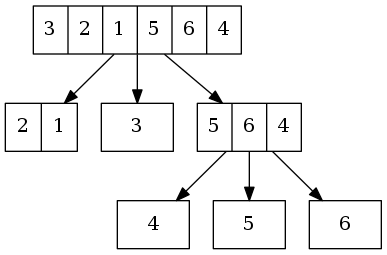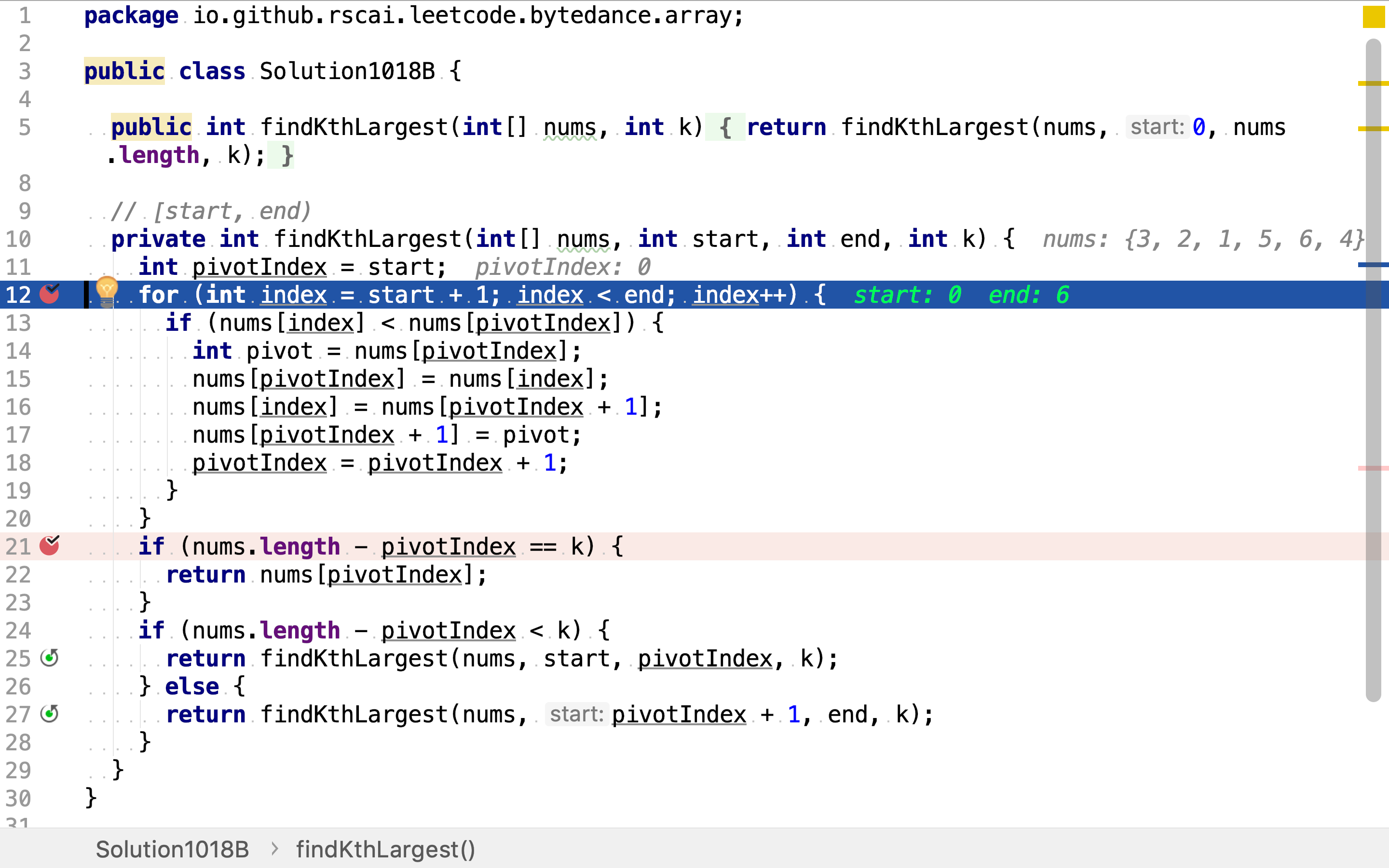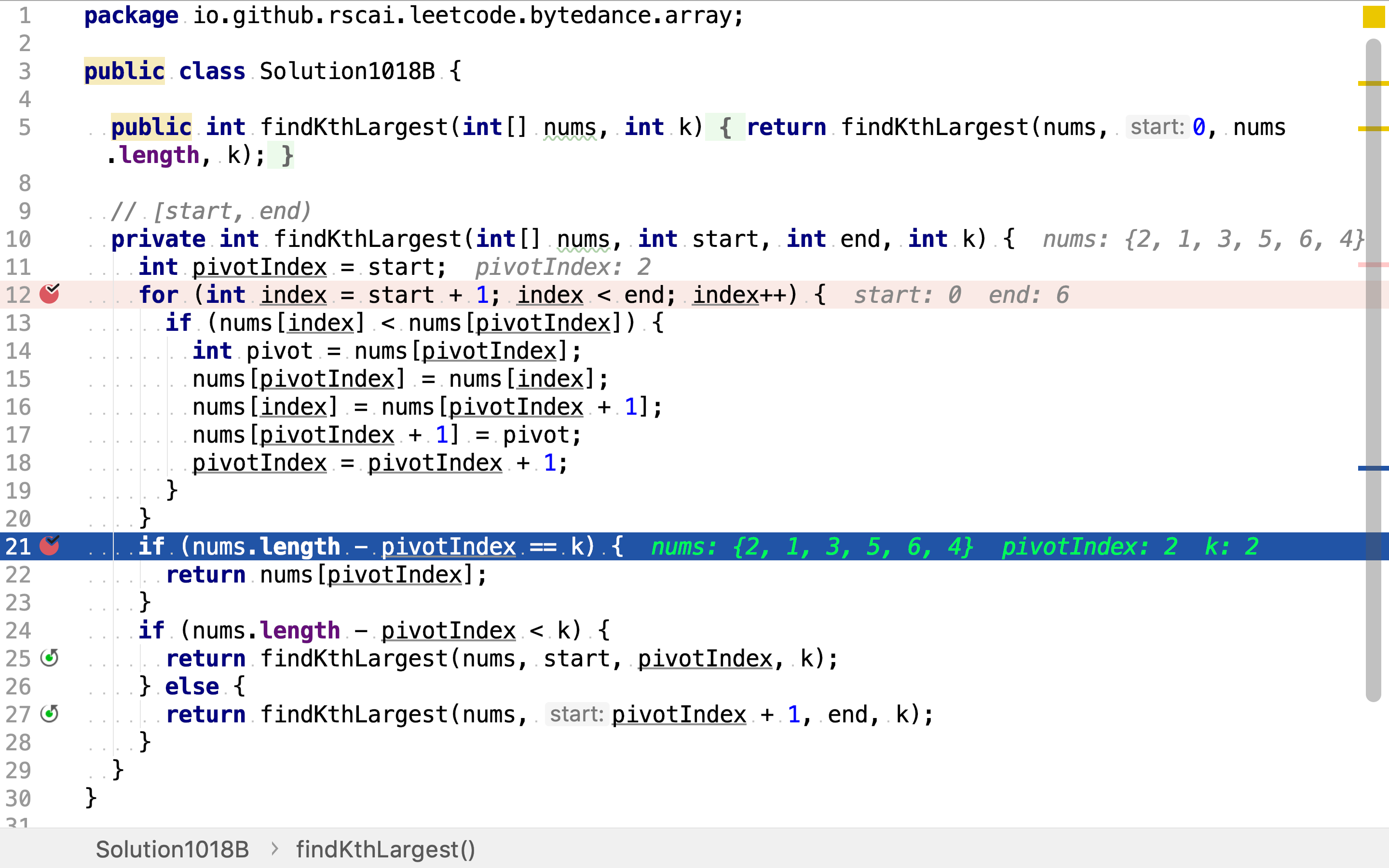数组中的第K个最大元素
题目
在未排序的数组中找到第 k 个最大的元素。请注意,你需要找的是数组排序后的第 k 个最大的元素,而不是第 k 个不同的元素。
示例 1:
输入: [3,2,1,5,6,4] 和 k = 2 输出: 5示例 2:
输入: [3,2,3,1,2,4,5,5,6] 和 k = 4 输出: 4说明:
你可以假设 k 总是有效的,且 1 ≤ k ≤ 数组的长度。
快速排序法
先使用JDK提供的快速排序算法排序数组,再取倒数第k个值。
快速排序
快速排序(英语:Quicksort),又称划分交换排序(partition-exchange sort),简称快排,一种排序演算法,最早由东尼·霍尔提出。在平均状况下,排序个项目要(大O符号)次比较。在最坏状况下则需要次比较,但这种状况并不常见。事实上,快速排序通常明显比其他演算法更快,因为它的内部回圈(inner loop)可以在大部分的架构上很有效率地达成。
演算法
快速排序使用分治法(Divide and conquer)策略来把一个序列(list)分为较小和较大的2个子序列,然后递回地排序两个子序列。
步骤为:
- 挑选基准值:从数列中挑出一个元素,称为「基准」(pivot),
- 分割:重新排序数列,所有比基准值小的元素摆放在基准前面,所有比基准值大的元素摆在基准后面(与基准值相等的数可以到任何一边)。在这个分割结束之后,对基准值的排序就已经完成,
- 递回排序子序列:递回地将小于基准值元素的子序列和大于基准值元素的子序列排序。
递回到最底部的判断条件是数列的大小是零或一,此时该数列显然已经有序。
代码
/*
* Sorting methods. Note that all public "sort" methods take the
* same form: Performing argument checks if necessary, and then
* expanding arguments into those required for the internal
* implementation methods residing in other package-private
* classes (except for legacyMergeSort, included in this class).
*/
/**
* Sorts the specified array into ascending numerical order.
*
* <p>Implementation note: The sorting algorithm is a Dual-Pivot Quicksort
* by Vladimir Yaroslavskiy, Jon Bentley, and Joshua Bloch. This algorithm
* offers O(n log(n)) performance on many data sets that cause other
* quicksorts to degrade to quadratic performance, and is typically
* faster than traditional (one-pivot) Quicksort implementations.
*
* @param a the array to be sorted
*/
public static void sort(int[] a) {
DualPivotQuicksort.sort(a, 0, a.length - 1, null, 0, 0);
}
复杂度分析
时间复杂度
Arrays.sort实现的是「Dual-Pivot」快速排序。时间复杂度是。
二分定位法
快速排序使用「基准(pivot)」将数组分为大小两个子数组,再递归排序两个子数组。当大小两个数组划分完成时,基准所处的位置即其在有序数组中最终所处的位置。所有小数子数组中的元素其最终位置都小于基准,所有大数子数组中的元素其最终位置都大于基准。所以,在确定基准元素所处位置后,就可以确定所求第k个元素处于大小两个子数组中的某一个。
举个例子,给定数组[3,2,1,5,6,4],求第2大的值。
首先,以3为基准,将小于3的值都移到左侧﹐大于等于3的值都移到右侧,得到数组[2,1,3,5,6,4]。基准3位置2(0-based),其是第4大元素,第2大的元素在右侧大于3的子数组中。
然后,在右侧子数组[5,6,4]中,以5为基准,将小于5的元素都移至其左侧,大于等于5的元素移至右侧,得到数组[4,5,6]。基准5位置1,正是所求第2大的元素。

代码
先使用「快速排序」中使用的基准法,将数组分为小于和大于基准的两部份。

然后,判断基准是否就是所求第k大值。若是则计算结束;若第k大值在小于基准的子数组中,则在其中递归寻找第k大值;若第k大值在大于基准的子数组中,则在其中递归寻找第k大值。

复杂度分析
时间复杂度
一般情况下,每一次基准都把数组分成相等的两部份。设初始数组长度,则每一次划分后的一个数组长度为。时间复杂度为所有数组长度的累和:
空间复杂度
使用四个变量start, end, pivotIndex, pivot。空间复杂度为。